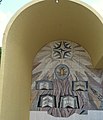St. Dominic Catholic Church (Miami, FL)
This article needs additional citations for verification. (April 2013) |

St. Dominic Catholic Church is a Catholic Church in Miami, Florida, US. It is part of the Roman Catholic Archdiocese of Miami and consists of 118 parishes, spanning Coral Springs in the north and Key West, Florida in the south.[1]
History
[edit]St. Dominic Catholic Church was established on the 20th of May, 1962 and was named in honor of Saint Dominic of Guzman, a 13th-century Catholic saint and founder of the religious Order of Preachers. It is located in 5909 NW 7th Street in Miami.
When the church was being established, the religious looked at possible permanent sites. In 1963 they acquired several buildings that were up for demolition. After renovations had been completed, the new site comprised the first church, rectory, and school of religion. In 1968 the Dominican Monastery in downtown Miami closed and the priests moved to St. Dominic, effectively creating its current priory.
In 1971 the church expanded and a statue and shrine of Our Lady of the Rosary was added. In the summer of 1979, the Most Reverend Archbishop Edward A . McCarthy placed the cornerstone of the new church, which was dedicated on March 15, 1981. In August 2011, the new stone altar was consecrated by Archbishop of Miami Thomas Wenski.[2][3]
Dominicans in the US
[edit]At first, the Spanish friars of Spain staffed St. Dominic parish, but in 1980 the pastoral care of the parish was entrusted to the Dominicans of the newly established Southern Province of St. Martin de Porres in the US. Although the presence of Spanish Dominican Friars in Florida dates back to the mid-16th century, the Dominicans were formally established in the US in 1805, by Fr. Edward Dominic Fenwick, OP.[4] Since then, their presence and ministry have grown. Today, the Dominican Friars have four provinces in the US. St. Martin de Porres, the Southern Province, forms part of the four. The Dominican Friars who staff St. Dominic Catholic Church today have been running it since the church was first established in 1962.
Four Provinces of Dominican Friars
[edit]- St. Martin de Porres Province (Southern United States)
- St. Joseph the Worker Province (Eastern United States)
- Holy Name of Jesus Province (Western United States)
- St. Albert the Great Province (Central United States)
The Parish
[edit]The early history of St. Dominic parish is tied to the history of the Diocese of Miami, which was created in August 1958 with the parish being created in May 1962. Both experienced tumultuous times in their early years. Just 90 miles away, Cuba had just experienced its Communist revolution, thus creating an influx of Cuban refugees. Black Americans were struggling for their civil rights, the Vietnam War was in process, and Vatican II had just “opened (its) windows” to Christ. This led to St. Dominic’s experiencing a “storm of change” and expansion during its early years.[5]
Parishioners have included natives and new settlers from the Northern US, the Caribbean, Central and South America. In its beginnings, St. Dominic parish served primarily an Anglo community. In the 2020s, the parish now serves a primarily Hispanic population.
There are currently many church groups and movements within the parish of St. Dominic, including Emaus, Cursillos de Cristiandad, CCD (religious education), RCIA (adult religious education and preparation for the sacraments), Grupo de Oración (prayer group part of the Charismatic Renovation), and the FIRST Catholic Action group in the US. Ministries include music (both choral and show choirs), Ministers of the Word and Ministers of the Eucharist.[6]
Architecture and Art
[edit]St. Dominic's layout is semi-circular in nature. On the church's exterior there are ten stained glass windows in the shape of arches depicting important themes in Catholicism. The entrance of the church consists of three major arches and underneath each arch there is a stone mosaic. The first mosaic from the left depicts the Dominican theologians that were important in the New World. The second and middle mosaic depicts Jesus "blessing and sending the 12 (Apostles) to announce the Good News" and St. Dominic welcoming the onlooker. The third mosaic on the right depicts a "boat bringing the first missionaries to the Florida peninsula." Both the stained glass windows and the arched mosaics were produced by the same artist, Father Domingo Iturgaiz from Navarre, Spain.
The church roof is in the shape of a triangular spire and its summit contains an iron cross that is illuminated at night. “Scalloping waves of barrel tiles” cover the roof.[2] The seating arrangement is also semi-circular and accommodates 850 persons.[2] There are six aisles that lead to the main altar. On the altar area there is a baptismal font and an ambo (pulpit). On the back wall of the sanctuary hangs a cross and two statues, one of Mary and one of St. Joseph. Alongside the walls with the stained glass windows are the Stations of the Cross by Spanish artist Jose Luis Coomonte.
Church pastors
[edit]- Fr. Angel Viscarra, O.P.
- Fr. Isidoro Vicente, O.P.
- Fr. Restituto Perez, O.P.
- Fr. Alberto Rodriguez, O.P. (1986-1993)
- Fr. Jorge Presmanez, O.P. (1993-2003)
- Fr. Alberto Rodriguez, O.P. (2003-2015)
- Fr. Eduardo Logiste OP (2015-present)
Gallery
[edit]-
Mosaic 1 in the middle
-
Mosaic 2 on the left
-
Mosaic 3 on the right
-
Sign and motto
References
[edit]- ^ "Archdiocese of Miami :: Home". Miamiarch.org. Retrieved 2014-03-05.
- ^ a b c Saint Dominic Church Dominican Fathers, A Dedication (Miami, 1981), "A New Church".
- ^ "An altar made of stone". M.miamiarch.org. 2011-08-09. Retrieved 2014-03-05.
- ^ "Dominican Friars". Opsouth.org. 1979-12-08. Archived from the original on 2014-03-06. Retrieved 2014-03-05.
- ^ "History - The Founder". Miamiarch.org. Retrieved 2014-03-05.
- ^ The Archdiocese of Miami. History of the Archdiocese of Miami 1958-2008. Strasbourg: Editions du Signe, 2007.





